Allegiance Estonia Died 1944, Laane County | Name Johan Pitka Years of service 1918–1920 Rank Rear admiral | |
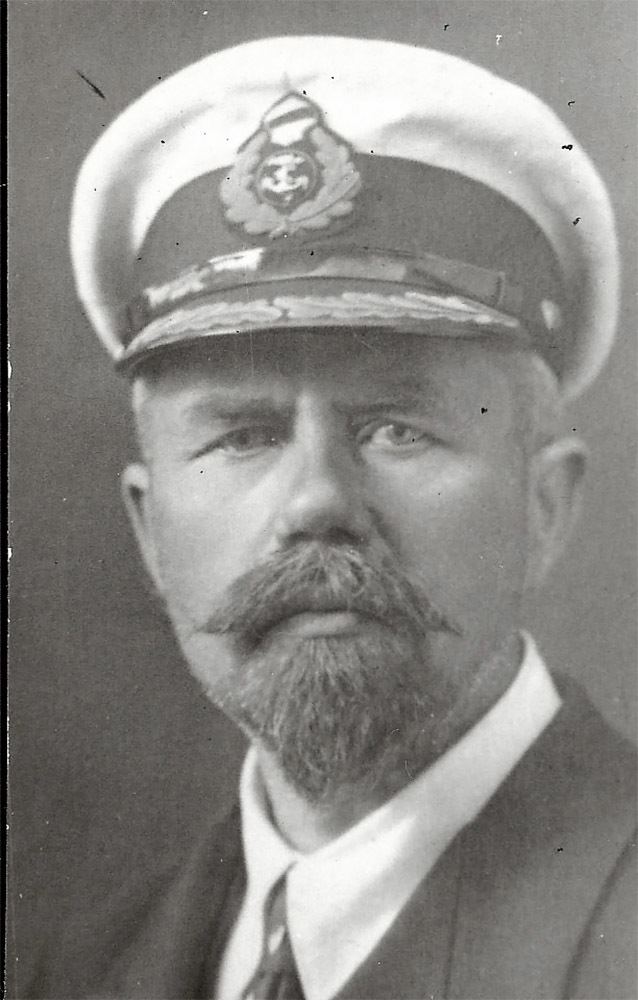 | ||
Battles/wars Estonian War of IndependenceWorld War II Awards Cross of Liberty (Estonia)Order of St Michael and St GeorgeOrder of LacplesisOrder of the Cross of the Eagle Similar People Ernst Podder, Johan Laidoner, Walter Cowan, Nikolai Kuzmin, Fyodor Raskolnikov | ||
Johan pitka 140 s nniaastap eva suusas it
Johan Pitka, VR I/1, (19 February 1872 in Jalgsema, Järva County, Estonia – disappeared September 1944 in Läänemaa, Estonia) was a famous Estonian military commander from the Estonian War of Independence until World War II.
Contents
- Johan pitka 140 s nniaastap eva suusas it
- Eesti merevgi 100
- Early life
- Estonian War of Independence
- Post war life
- Awards
- Writings
- Disappearance
- References
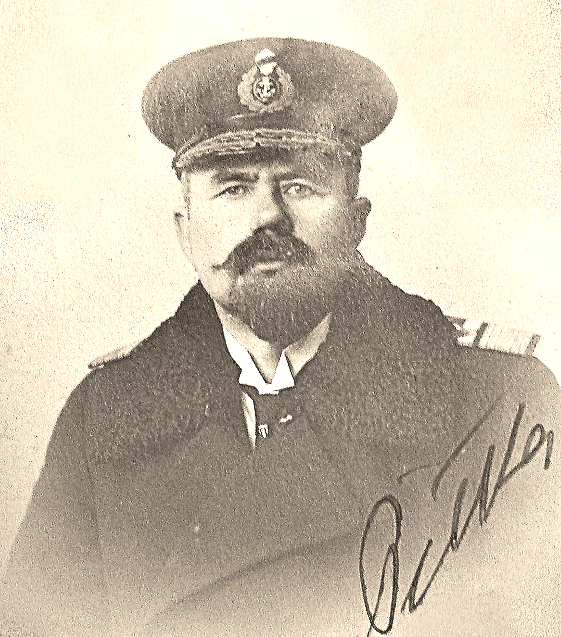
Eesti merevägi 100
Early life

Pitka studied at Käsmu, Kuressaare and Paldiski marine schools and became a Master Mariner. From 1889 to 1907 he worked on sailing ships. In 1895 he was on the first sailing ship to transit Germany's Kiel Canal. From 1904-11, he lived in Great Britain. After the beginning of the 1917 Russian Revolution Pitka became active in society and started organizing returning Estonian soldiers who fought in the Russian Army during World War I. After the communists sentenced him to death he was forced to go underground. When the Germans occupied Estonia in 1918, Pitka began to organize the Defence League.
Estonian War of Independence
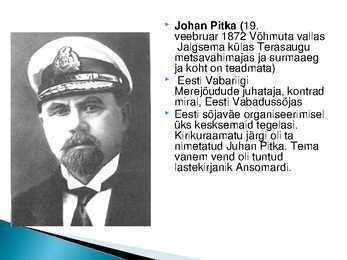
In the Estonian War of Independence, the Defence League was one of the main forces of the Republic of Estonia, and at that time Pitka started organizing armored trains. The first one was ready 10 days after the start of the war, and the second became ready two weeks later. In total, five armored trains were built during the war, and they played a crucial role in the Estonian victory. Many called Pitka the "father of armored trains" for this.
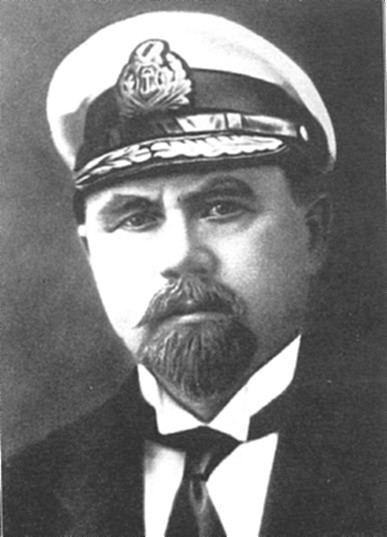
Pitka also was the main organizer of the Estonian Navy. In December 1919 he became Commander-in-Chief of the navy and led it in all major operations including supporting the 1st Division in the capture of Narva from the Russian SFSR and supporting the 3rd Division by attacking Landeswehr naval fortifications at Riga. In September he achieved the rank of Rear Admiral. Pitka retired in November 1919. In 1920, for his service in the Baltic during and after the 1917 Russian Revolution, Pika was awarded a knighthood, Knight Commander of St. Michael and St. George (KCMG) by Britain's King George V upon the recommendation of British Admiral Walter Cowan.
Post-war life
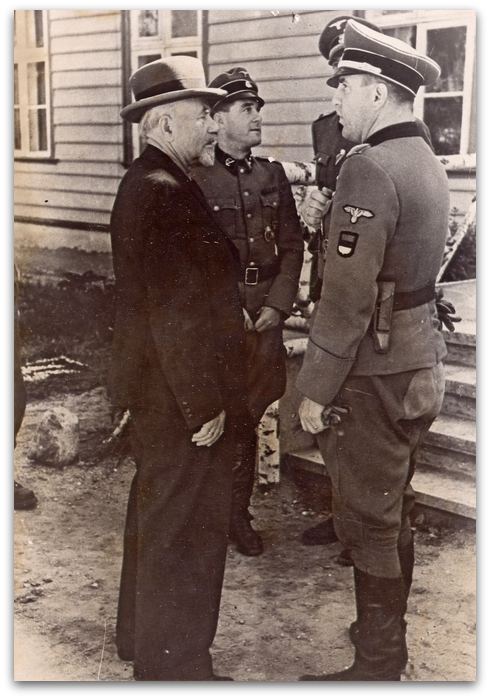
As a former merchant seaman and Canadian Pacific Railway Co. representative, Pitka had some familiarity with Canada's immigration policies, the availability of land for homesteading and Canada's natural beauty. The promise of new roads in and extension of the railway caused Pitka to establish a settlement in the Sowchea area of Fort St. James British Columbia. The Sowchea area was located on the other side of Stuart Lake from the Hudson Bay Co. trading post.
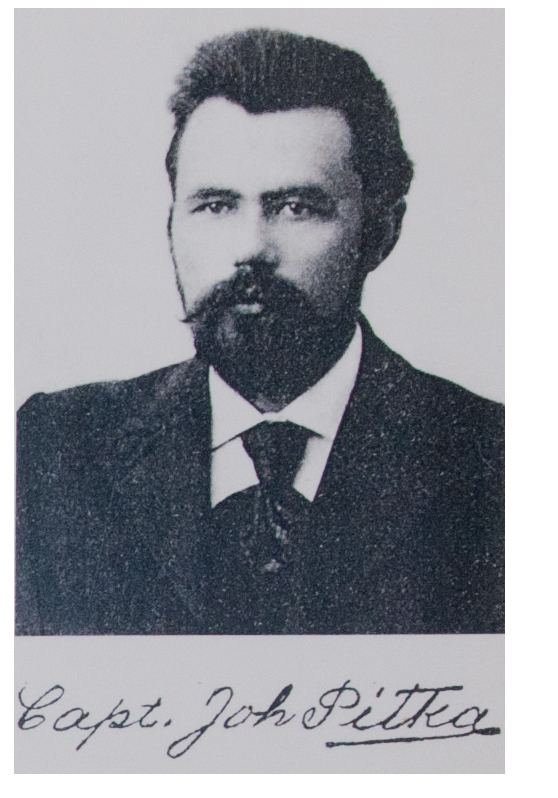
On April 3, 1924, a group of Estonian settlers arrived in Fort St. James whose population was about 50 Caucasians and 500 indigenous natives. The initial settlers were Pitka's family consisting of: Lady Mari-Helene Pitka, sons Edward and Stanley, daughters Saima and Linda and son-in law Lt. Aleksander Päären; families Andrekson, Rosin and Saar; Col. Steinman, Mr. Nilk and Mr. Pärtelson with wives; and Messrs. Kuusk, Olem, Puhm, Sulakatk, Vaimel, Unger and Wilmanson. They began homesteading on more than 300 hectares of land. The Estonian settlers were happy living with the Hudson’s Bay officials, the local Dakelh people and other residents. Though they tried growing crops, sheep farming, dairy farming and sawmilling, a sustainable existence proved elusive, largely because it was extremely difficult to get their goods to market given a change in the Provincial Government and a devaluation of the Canadian dollar during the depression. The delayed local development and frustrating access to markets caused all members of the group to move elsewhere or return to Estonia by 1932. Landmarks around Fort St. James still bear their name (e.g. Pitka Mountain, Pitka Bay, Pitka Bay Resort, Lind(a) Lake, Colony Point and Paaren’s Beach Provincial Park) In 2009 a monument honouring Pitka was unveiled in Fort St. James.
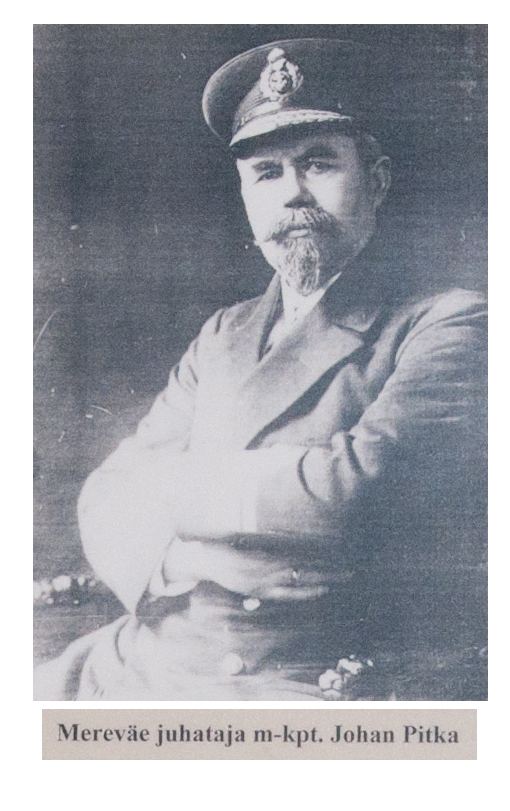
Upon return to Estonia some prosperous years followed for the Pitkas. Johan Pitka was one of the leaders of the League of Liberators for a short time but left the organization in 1932. In 1937 he was also a member of the National Constituent Assembly. After the Soviet occupation in June 1940, Pitka escaped from Estonia to Finland. In 1941 tragedy struck the Pitka family, their three sons were arrested by the Soviet occupiers and perished. In 1944 Pitka returned to Estonia to organize military resistance to fight for Estonia's independence. Pitka is thought to have died in a 1944 battle. Pitka's wife and daughters with their husbands fled to Sweden in 1944, re-immigrated to Canada in 1948, settled in Vancouver, B.C. and are buried there.
Awards
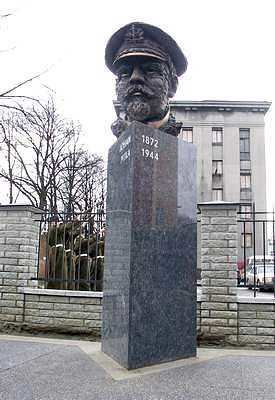
In January 1920 to give recognition to his activities during the Great War, the KCMG Knight Commander of St. Michael and St. George was awarded to him by England's King George V. The Estonian government valued his contribution by awarding him the Cross of Liberty I/1. Pitka is also recipient of the Latvian military Order of Lāčplēsis, 2nd class.
Writings
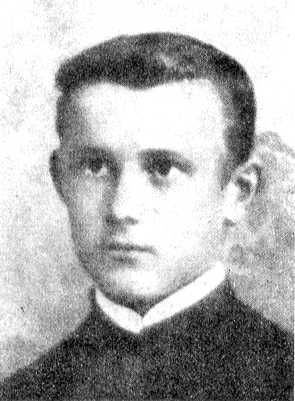
Pitka was also a prolific author. He translated a book by Irving Cooper about fitness and health from English to Estonian in 1935 after he had returned from Canada. He also translated a spiritual work with a foreword by H.P. Blavatsky. Pitka wrote about his years commanding the barque Lilly and also wrote his other memoirs in four volumes that were edited by Evald Past.
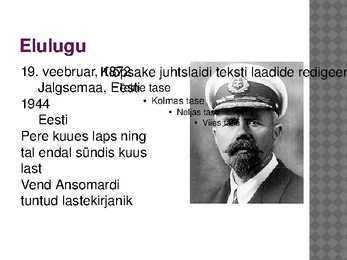
Pitka, J., Minu Mälestused suure ilmasõja algusest Eesti vabadussõja lõpuni, Tallinna Eesti Kirjastus-Ühisus, 1921
Pitka, J. Teed töelisele tervisele, tõlgitud inglise keelest, author Irving S. Cooper, koostõlkija Saima Smith, Eesti Ühistrükikoda, Tallinn, 1935
Pitka, J., Minu Mälestused I, Laevandus, Kiirtrükk, Tallinn, 1937
Pitka, J., Minu Mälestused II, Laevandus, Tallinn, Ilutrükk, Tartu, 1938.
Pitka, J., Minu Mälestused III, Laevandus, Tallinn, Ilutrükk, Tartu, 1939.
Pitka, J., Minu Mälestused IV, Orkaanis ja dûnglis, Vikerlane, Tallinn, Ilutrükk, Tartu, 1939.
Pitka, J., Väljavõtteid "Kuldsete õpetuste raamatust", avaldanud H.P. Blavatsky, eestitatud J. Pitka, Eesti Ühistrükikoda, Tallinn, 1939.
Pitka, J., Minu Mälestused 1914-1920: Suure Ilmasõja algusest Eesti Vabadussõja lõpuni, Olion, Tallinna Raamatutrükikoda, 1993, [Reprint of his 1921 book.] ISBN 5450013221
Pitka, J. Teed töelisele tervisele, tõlgitud inglise keelest, author Irving S. Cooper, koostõlkija Saima Smith, Nebadon, Ühiselu, Tallinn, 1994
Pitka, J., Kuldsed aasta "Lillyga", Mats, Tallinna Raamatutrükikoda, 1998, ISBN 9985510399
Disappearance
Pitka returned from Finland to Estonia in spring 1944. In September 1944 the Germans were retreating, and Jüri Uluots organized a new Estonian government headed by Otto Tief. Pitka organized the last defence of Tallinn against the advancing Red Army. The circumstances of his disappearance remain unknown. Several stories relate that he died either to a battle against a Soviet tank group or perishing on the stormy Baltic Sea when trying to make his way to Sweden aboard one of the last small boats fleeing the country.
